Choosing the right kitesurfing board size is crucial for optimal performance, control, and enjoyment․ This guide helps you understand how board size impacts your riding experience, covering key factors like rider weight, skill level, and wind conditions to ensure you select the perfect board for your needs․
What This Guide Will Cover
This guide provides a comprehensive overview of kitesurfing board size selection, covering types of boards, factors like wind speed, rider weight, and skill level, and how these elements influence your choice․ It also includes tips on testing boards, understanding kite and bar compatibility, and optimizing your entire kitesurfing setup․ Whether you’re a beginner or an advanced rider, this guide offers practical advice to help you make informed decisions and enhance your kitesurfing experience․
Understanding the Basics of Kitesurfing Board Size
Kitesurfing board size is determined by factors like rider weight, skill level, and wind conditions․ Larger boards offer stability, while smaller boards provide agility and speed․
Types of Kitesurfing Boards and Their Purposes
Kitesurfing boards vary in design, catering to different riding styles and conditions․ Freestyle boards are lightweight and maneuverable, ideal for tricks and aerials․ Wave boards are designed for surfing waves, offering directional control and stability․ Big air boards are optimized for high jumps and powerful takeoffs․ All-round or twintip boards provide versatility, suitable for beginners and general riding․ Each type is tailored to specific needs, ensuring riders can match their board to their preferred style and performance goals․
Key Factors Affecting Board Size: Wind Speed, Rider Weight, and Skill Level
Wind speed, rider weight, and skill level are critical in determining the ideal kitesurfing board size․ Lighter winds require larger boards for better floatation, while stronger winds favor smaller boards for control․ Rider weight influences buoyancy, with heavier riders needing larger boards․ Skill level also plays a role, as beginners benefit from larger, more stable boards, while advanced riders can opt for smaller, more maneuverable ones․ Balancing these factors ensures optimal performance and comfort on the water․
How to Choose the Right Board Size for Your Needs
Assess your riding style, local wind conditions, and skill level to determine the optimal board size․ Test different sizes to find the perfect balance of control and performance․
Understanding the Relationship Between Kite Size and Board Size

Kite size directly impacts board size, as larger kites generate more power, requiring smaller boards for control, while smaller kites need larger boards for stability․ Rider weight, skill level, and wind conditions also influence this balance․ A larger kite allows for easier planing in light winds but may overwhelm lighter riders․ Conversely, smaller kites suit stronger winds and advanced riders seeking agility․ Matching kite and board sizes ensures optimal performance, maneuverability, and ease of control in various conditions․
Why Board Width and Length Matter for Different Riding Styles
Board width and length significantly influence performance across various riding styles․ Wider boards offer greater stability and buoyancy, ideal for beginners and freestyle tricks, while narrower boards enhance speed and agility for advanced riders․ Longer boards excel in light winds and wave riding, providing more lift and float, whereas shorter boards deliver sharper turns and better control for freestyle maneuvers․ Balancing these dimensions ensures the board suits your riding style, skill level, and wind conditions for optimal performance․
How to Test and Compare Different Board Sizes Before Buying
Testing and comparing board sizes is essential before making a purchase․ Visit your local beach or a kite shop to try out different sizes in real conditions․ Pay attention to how the board feels underfoot, its stability, and maneuverability․ Compare performance in varying wind speeds and water conditions to gauge responsiveness․ Note how each size affects your ability to stay balanced, turn, and control the board․ This hands-on approach ensures you select a board that matches your riding style, skill level, and local conditions for an optimal kitesurfing experience․
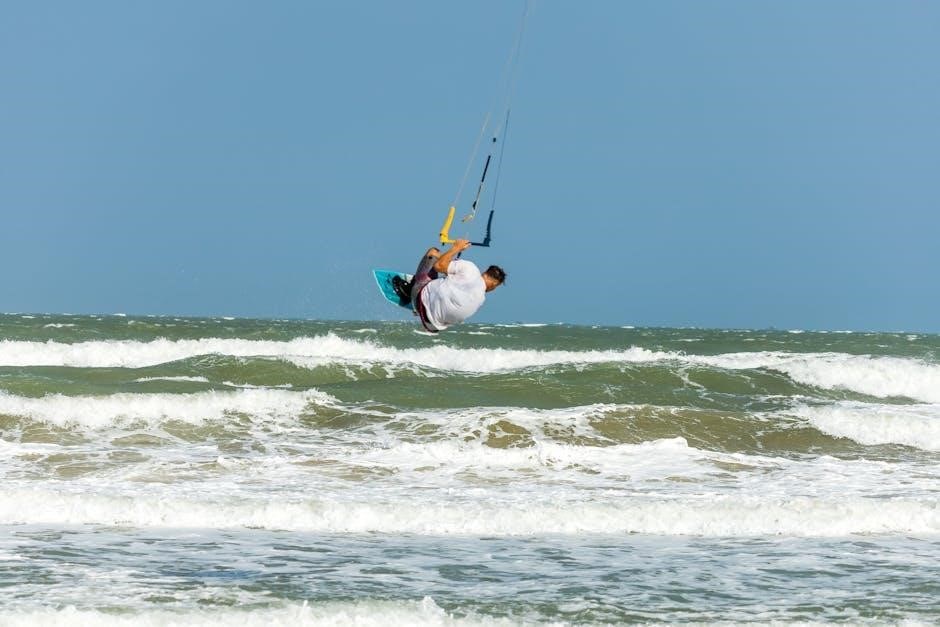
Factors Influencing Kitesurfing Board Size
Rider weight, skill level, and wind conditions are key factors influencing kitesurfing board size․ A proper selection ensures balance, control, and optimal performance during rides․
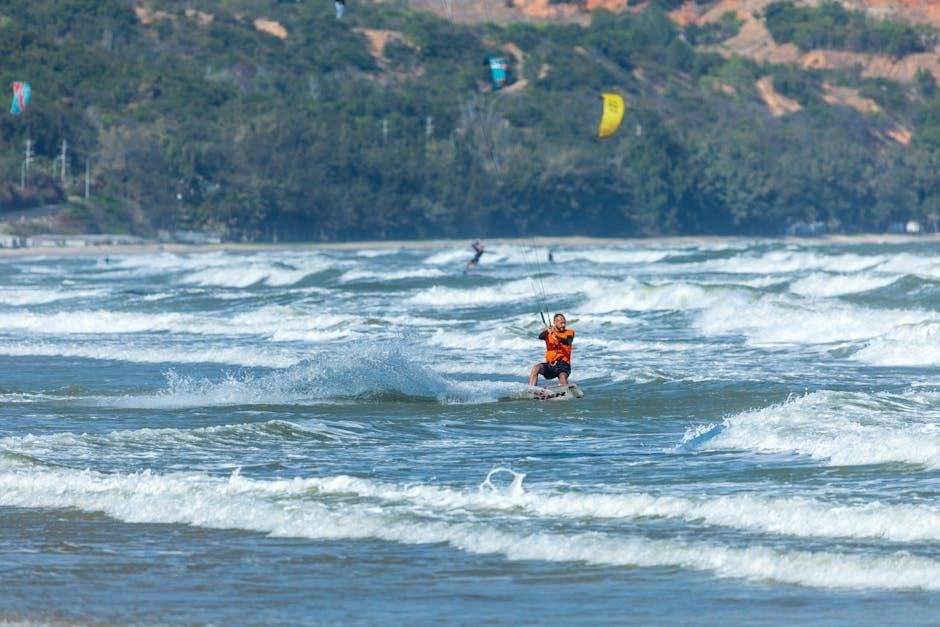
The Role of Rider Weight and Body Type in Board Selection
Rider weight and body type significantly influence kitesurfing board size․ Heavier riders require larger boards for buoyancy and stability, while lighter riders can opt for smaller, more maneuverable boards․ Body type, including height and build, also plays a role in determining the ideal board dimensions․ Proper board selection based on these factors ensures better performance, control, and comfort during rides, making it essential to consider them when choosing your kitesurfing equipment․
How Skill Level Impacts Board Size and Performance
Skill level greatly affects the choice of kitesurfing board size and performance․ Beginners benefit from larger boards with more buoyancy and stability, making it easier to stay upright and balance․ Intermediate to advanced riders can opt for smaller, lighter boards that allow for faster turns and tricks․ As riders progress, their board size often decreases, enabling more dynamic and responsive riding experiences tailored to their growing skills and style preferences․
Wind Conditions and Their Effect on Optimal Board Size
Wind conditions significantly influence the optimal board size for kitesurfing․ In light winds, larger boards provide better buoyancy and stability, helping riders stay afloat and maintain control․ Stronger winds favor smaller boards, as they are easier to handle and maneuver, reducing the risk of being overpowered․ Medium winds offer a balance, allowing riders to use all-around board sizes․ Matching board size to wind speed ensures a more enjoyable and controlled riding experience, regardless of the conditions․
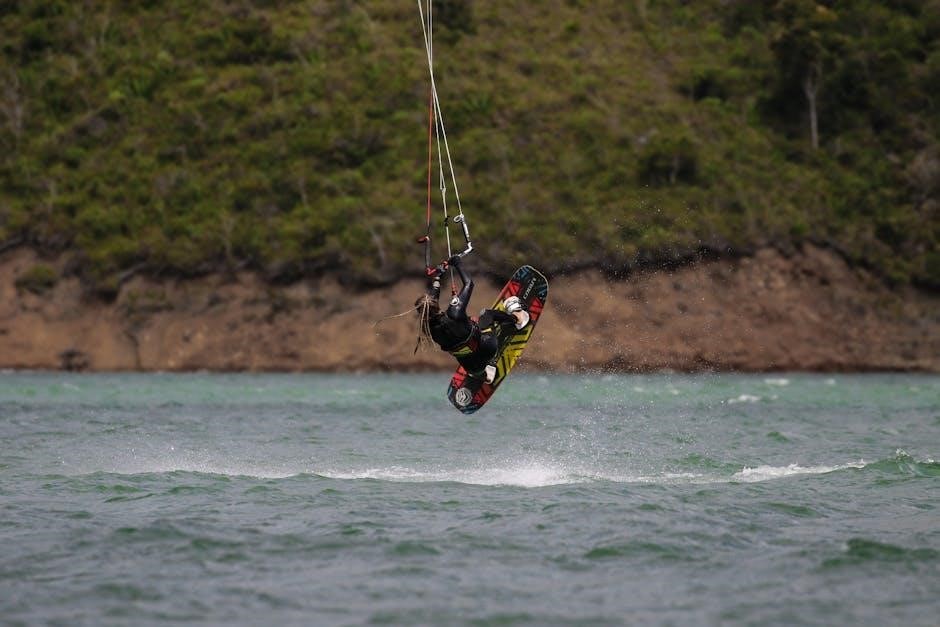
Kitesurfing Board Size Chart and Recommendations
A detailed chart for beginners and advanced riders, offering size recommendations based on weight, skill level, and riding style to ensure optimal performance and control in various conditions․
A Detailed Size Chart for Beginners and Advanced Riders
This chart provides a clear guide for selecting the ideal board size based on rider weight, skill level, and typical wind conditions․ For beginners, smaller boards (130-140cm) are recommended for easier control and stability, while advanced riders may prefer larger boards (140-150cm) for better performance in varying winds․ The chart also considers riding styles, offering tailored recommendations for freestyle, wave, and big air disciplines to ensure optimal maneuverability and fun on the water․
Board Size Recommendations for Freestyle, Wave, and Big Air Riding
Freestyle riders typically opt for shorter, wider boards (130-138cm) for agility and trick execution․ Wave riders prefer longer, narrower boards (140-150cm) for better float and directional control․ Big air enthusiasts choose medium-length boards (138-145cm) to balance speed and lift․ Each style demands specific dimensions to maximize performance, ensuring riders can execute maneuvers smoothly and enjoy their preferred discipline with confidence and precision․
How to Adjust Board Size Based on Personal Preference and Progression
As you gain experience, consider adjusting your board size to suit your riding style․ Beginners may prefer larger boards for stability, while advanced riders might downsize for increased agility․ Test different sizes in various conditions to find your ideal fit․ Personal preference plays a significant role, so experiment and adapt your board size as your skills evolve․ This ensures your setup remains optimized for both comfort and performance, allowing you to progress seamlessly in your kitesurfing journey․
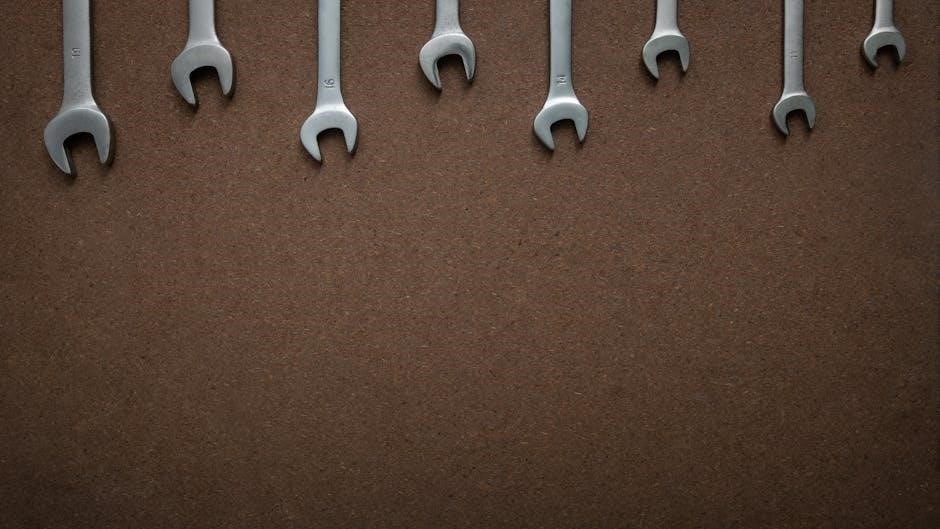
Additional Considerations for Kitesurfing Equipment
When selecting gear, consider kite size, bar length, and harness fit to ensure a balanced setup․ These elements work together to enhance control and overall performance․
The Importance of Kite Size and Type in Relation to Board Size
Kite size and type significantly impact board performance․ A larger kite provides more power, often requiring a smaller board for control, while a smaller kite pairs better with a larger board for stability․ Freestyle kites, with faster turning, work well with smaller, maneuverable boards, whereas wave kites, offering drift, suit longer boards for carving․ Matching kite size to rider weight and wind conditions ensures optimal balance, enhancing overall riding experience and control․ Balancing these elements is key for progression and enjoyment in kitesurfing․
Choosing the Right Bar Size for Your Kitesurfing Setup
Bar size plays a crucial role in kite control and responsiveness․ A shorter bar offers quicker turning, ideal for freestyle tricks, while a longer bar provides stability and easier handling, suitable for beginners or wave riding․ Rider height and arm span also influence bar size, ensuring comfortable reach and control․ Proper bar size ensures smooth communication between kite and rider, enhancing performance and safety․ Always test different bar sizes to find the perfect fit for your style and kite setup․
How to Ensure Your Entire Kitesurfing Kit is Balanced and Optimized
A well-balanced kitesurfing kit is essential for peak performance․ Ensure your kite, bar, lines, and board are compatible and sized appropriately for your weight and skill level․ Adjust kite settings to match wind conditions, and pair your board size with the kite’s power output․ Regular maintenance and proper storage extend equipment life․ Testing different configurations on the water helps refine your setup, ensuring harmony between components for a seamless riding experience․
Tips for Traveling with Your Kitesurfing Board
Packing efficiently and using a high-quality bag is crucial․ Protect your board with padding and secure it during travel․ Choose destinations with suitable wind conditions for your board size and check airline policies for sports equipment to avoid extra fees․
How to Pack Your Board and Kitesurfing Gear Efficiently
Packing your kitesurfing gear requires careful planning to ensure everything fits safely․ Use a high-quality board bag with padding to protect your board during travel․ Roll your wetsuit and store it in a separate compartment to save space․ Organize smaller items like harnesses, bars, and lines in sealed bags․ Check airline policies for sports equipment and pack lightweight gear to avoid extra fees․ Efficient packing ensures your gear arrives in perfect condition, ready for your next adventure․
Best Destinations for Kitesurfing Based on Board Size and Conditions
Top kitesurfing destinations vary by board size and conditions․ Egypt’s shallow waters suit larger boards for light winds, while Brazil’s consistent breezes work well with medium-sized boards․ Cape Town’s strong winds favor smaller boards․ Choose destinations that match your board size and skill level for optimal performance․ Research local wind patterns and water conditions to ensure your gear aligns with the environment, enhancing your riding experience and safety․
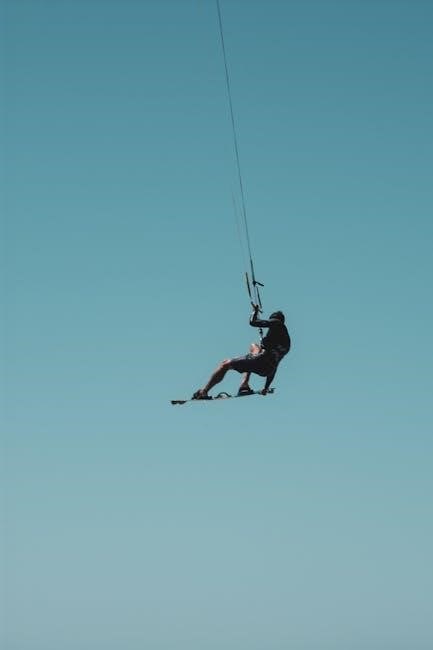
Safety and Maintenance for Your Kitesurfing Board
Always use a leash to prevent losing your board․ Regularly inspect for damage, clean thoroughly, and store properly․ Ensure your kite size and bar setup match your board for safe, balanced riding conditions․
Safety Precautions to Avoid Losing Your Board While Riding
Always use a board leash to keep your kiteboard attached to your harness, preventing loss during crashes or strong gusts․ Ensure your harness and quick-release are securely fastened․ Before entering the water, double-check all connections and attachments․ Avoid riding in excessively windy conditions where control may be compromised․ Additionally, practice self-rescue techniques and stay aware of your surroundings to minimize risks․ Regularly inspect your leash for wear and tear to ensure reliability․
How to Maintain and Care for Your Kitesurfing Board
Regularly clean your board with fresh water to remove sand, salt, and debris․ Avoid exposing it to direct sunlight for extended periods, as this can cause damage․ Store your board in a cool, dry place, preferably in a protective bag to prevent dings and scratches․ Inspect the board frequently for damage and repair any dings promptly to prevent further issues․ Always handle the board with care to avoid accidental damage, and ensure it is completely dry before storing to prevent mold or mildew․